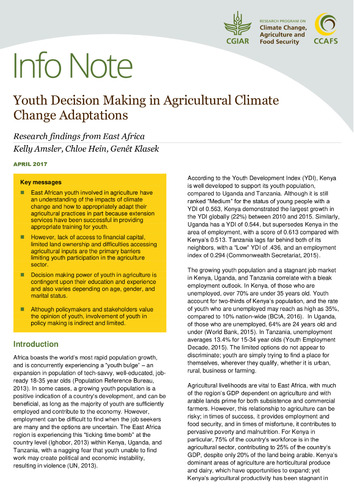Youth Decision Making in Agricultural Climate Change Adaptations: Research findings from East Africa
Abstract
Africa boasts the world’s most rapid population growth, and is concurrently experiencing a “youth bulge” – an expansion in population of tech-savvy, well-educated, job-ready 18-35 year olds (Population Reference Bureau, 2013). In some cases, a growing youth population is a positive indication of a country’s development, and can be beneficial, as long as the majority of youth are sufficiently employed and contribute to the economy. However, employment can be difficult to find when the job seekers are many and the options are uncertain. The East Africa region is experiencing this “ticking time bomb” at the country level (Ighobor, 2013) within Kenya, Uganda, and Tanzania, with a nagging fear that youth unable to find work may create political and economic instability, resulting in violence (UN, 2013).
According to the Youth Development Index (YDI), Kenya is well developed to support its youth population, compared to Uganda and Tanzania. Although it is still ranked “Medium” for the status of young people with a YDI of 0.563, Kenya demonstrated the largest growth in the YDI globally (22%) between 2010 and 2015. Similarly, Uganda has a YDI of 0.544, but supersedes Kenya in the area of employment, with a score of 0.613 compared with Kenya’s 0.513. Tanzania lags far behind both of its neighbors, with a “Low” YDI of .436, and an employment index of 0.294 (Commonwealth Secretariat, 2015).
The growing youth population and a stagnant job market in Kenya, Uganda, and Tanzania correlate with a bleak employment outlook. In Kenya, of those who are unemployed, over 70% are under 35 years old. Youth account for two-thirds of Kenya’s population, and the rate of youth who are unemployed may reach as high as 35%, compared to 10% nation-wide (BCtA, 2016). In Uganda, of those who are unemployed, 64% are 24 years old and under (World Bank, 2015). In Tanzania, unemployment averages 13.4% for 15-34 year olds (Youth Employment Decade, 2015). The limited options do not appear to discriminate; youth are simply trying to find a place for themselves, wherever they qualify, whether it is urban, rural, business or farming.
Agricultural livelihoods are vital to East Africa, with much of the region’s GDP dependent on agriculture and with arable lands prime for both subsistence and commercial farmers. However, this relationship to agriculture can be risky; in times of success, it provides employment and food security, and in times of misfortune, it contributes to pervasive poverty and malnutrition. For Kenya in particular, 75% of the country’s workforce is in the agricultural sector, contributing to 25% of the country’s GDP, despite only 20% of the land being arable. Kenya’s dominant areas of agriculture are horticultural produce and dairy, which have opportunities to expand; yet Kenya’s agricultural productivity has been stagnant in recent years. For highly arable Uganda, agriculture employs 66% of its labor force, comprises 50% of its exports, and creates 23% of its GDP. The dominant crop for food security is maize, followed by beans, with coffee being the main export, although Uganda has suffered heavy harvest losses in recent years. For Tanzania, while 75% of its population is involved in agriculture, the sector contributes only 31.5% of its GDP. Despite the fact that Tanzania is largely self-sustaining in the staple crop of maize, it lags far behind global average maize yields (Feed the Future, 2016).
Although farming is a common livelihood, it is a risky one, with climate change as one of the contributing factors. Farmers in Kenya, Uganda, and Tanzania are heavily dependent on rainfall, and therefore highly vulnerable to inconsistent weather events, such as droughts, floods, intense heat, and severe cold. Such extremities and uncertainties have a negative impact on agriculture, thwarting the involvement of young people.
The status of a burgeoning youth population in East Africa, precarious employment opportunities, and the alteration of traditional agricultural practices in the face of climate change has prompted the need to explore the role of youth in adaptive farming practices; specifically, the extent of their decision making power in agricultural adaptations to climate change. This information is critical to understanding the future of agriculture and youth in Kenya, Uganda, and Tanzania.

